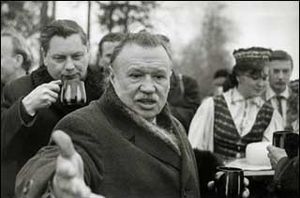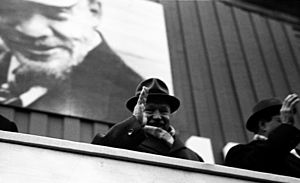Antanas Sniečkus facts for kids
Quick facts for kids
Antanas Sniečkus
|
|
|---|---|
 |
|
| First Secretary of the Communist Party of Lithuania | |
| In office 15 August 1940 – 22 January 1974 |
|
| Preceded by | Office created |
| Succeeded by | Petras Griškevičius |
| Personal details | |
| Born |
Antanas Gintautas Sniečkus
7 January 1903 Būbleliai, Kovno Governorate, Russian Empire |
| Died | 22 January 1974 (aged 71) Druskininkai, Lithuanian SSR, Soviet Union |
| Political party | Communist Party of Lithuania (1920–1974) |
| Spouse | Mira Bordonaitė |
| Children | Vladas and Marytė |
Antanas Sniečkus (born January 7, 1903 – died January 22, 1974) was an important Lithuanian communist politician. He served as the First Secretary of the Communist Party of Lithuania for a very long time. This role made him the most powerful person in Lithuania from August 15, 1940, until his death in 1974.
Contents
Antanas Sniečkus: His Early Life and Political Journey
Antanas Sniečkus was born in 1903 in the village of Būbleliai, near Šakiai. During World War I, his family moved to Russia. There, he witnessed the Russian Revolution of 1917.
In 1919, his family returned to Lithuania. By 1920, Sniečkus had joined the Bolshevik Party, a communist group. He was soon arrested for working against the government. After being released on bail, he fled to Moscow.
Becoming a Communist Agent
In Moscow, Sniečkus became an agent for the Comintern. This was an organization that worked to spread communism worldwide. He gained the trust of important communist leaders like Zigmas Angarietis. Soon, he became a member of the Central Committee of the Communist Party of Lithuania.
In 1926, the Comintern sent Sniečkus back to Lithuania. His job was to lead the Communist Party of Lithuania, which was banned and operating secretly. He took over after the previous leader, Karolis Požėla, was executed.
Arrests and the Soviet Takeover
From 1926 to 1930, Sniečkus continued his secret activities in Lithuania. He was arrested again in 1930 and sent to Kaunas Prison. In 1933, he was released in a prisoner exchange with the Soviet Union.
He returned to Lithuania in 1936. In 1939, he was arrested once more and sentenced to eight years in prison. However, his time in prison was cut short.
Lithuania Joins the Soviet Union
After the 1940 Soviet ultimatum to Lithuania and the Soviet military occupation, Sniečkus was released from prison on June 18, 1940. He then became the head of the Department of National Security.
A Soviet official named Vladimir Dekanozov arrived in Lithuania on June 15. His goal was to make Lithuania part of the Soviet Union. Sniečkus helped carry out Dekanozov's orders. He created a climate of fear before the elections for the new People's Seimas on July 14. Only the Communist Party and its allies could run. People were pressured to vote, and the election results were changed.
On July 21, the People's Seimas announced that Lithuanians wanted to join the Soviet Union. On August 3, the Supreme Soviet of the USSR officially took control of Lithuania. This created the Lithuanian Soviet Socialist Republic. From August 15, Antanas Sniečkus became the most powerful person in Lithuania.
Deportations and Wartime Activities
Sniečkus was involved in the first mass deportations of Lithuanians. This happened between June 14 and 19, 1941. Many Lithuanians were sent to Siberia. Even Sniečkus's own brother and his family were deported, and his brother died there.
Later, when Soviet leader Nikita Khrushchev offered amnesty, many prisoners were released. However, Sniečkus did not allow many of them to return to Lithuania.
In 1942, Sniečkus led the Lithuanian Partisan Movement from Moscow. He had retreated there with the Red Army in 1941. This group was meant to show that Soviet partisan actions in Lithuania were "Lithuanian." However, many groups sent from Moscow reported directly to the main Soviet command.
Later Years and Family
In 1944, as the Red Army advanced, Sniečkus's mother fled to the West. She disowned her son. Two of his brothers and three sisters also fled to the West. Sniečkus returned to Lithuania in 1944 with other communist officials.
In his later years as leader, Sniečkus showed some support for Lithuanian national interests. He even defended old communist friends from persecution by Moscow in 1949-1950. Lithuania was the only Soviet republic where old communists were not widely arrested. His policies began to show a more national character. This included sometimes delaying orders from Moscow and asking for special treatment for Lithuania.
His wife, Mira Bordonaitė, was also a strong communist. She spent many years in prison. Sniečkus had two children, Vladas and Marytė.
After His Death
Antanas Sniečkus died on January 22, 1974.
A village for workers of the Ignalina Nuclear Power Plant was founded in 1975. It was named Sniečkus, after him. In 1992, the town was renamed Visaginas. It became a city in 1995.
Some efforts have been made in Lithuania to understand Sniečkus's role in history.
See Also
 In Spanish: Antanas Sniečkus para niños
In Spanish: Antanas Sniečkus para niños
- Lithuanian partisans (1941)
- 1940 Soviet ultimatum to Lithuania
- Occupation of the Baltic states
- Baltic states under Soviet rule


